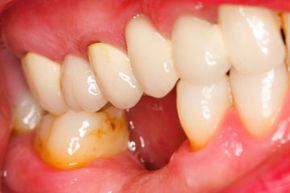The food and drinks you consume throughout the day leave behind a sticky film or residue on your teeth. While most people appreciate the need for regular brushing and flossing to prevent cavities, you may be unaware of what can happen when excess plaque gets trapped below your gum line. Over time, plaque that builds up around the gums hardens into a substance called tartar. This tartar creates a gap between the teeth and the gums, which allows bacteria to travel below the gum line, resulting in a condition known as gingivitis. Gingivitis is characterized by pain and swelling of the gums, which can lead to infection and more serious oral health problems if left untreated.
Even people who brush and floss regularly are not necessarily immune from the effects of this disease. In fact, the majority of adults and adolescents suffer from some level of gingivitis, and many don't even know it [source: Net Wellness]. While advanced cases of this condition can result in pain or tenderness, people with mild gingivitis may not have any pain. Some sure signs of gingivitis include red or swollen gums, a bad odor or unpleasant taste in the mouth or even visible separation between gums and teeth [source:University of Iowa].
Advertisement
Unfortunately, gingivitis is only the first step on the path to poor oral health. Left untreated, gingivitis develops into a condition known as periodontitis. With periodontitis, it's not just the gums that are at risk, but also the underlying ligaments and bone structure that support the teeth. Plaque, tartar and bacteria below the gums result in permanent damage to these structures, which causes the teeth to loosen or shift away from one another. Periodontitis can eventually cause tooth loss [source:University of Iowa].
Ready to arm yourself in the fight against gingivitis? Read on to learn how you can protect yourself from gum disease.
Advertisement

